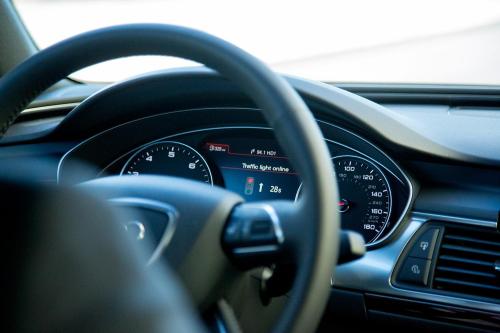
Las Vegas thrives on gambling, but Audi introduced a feature in 2016 that took much of the guesswork out of driving down the Strip. For the first time, motorists in compatible cars could tell exactly when a traffic light was about to turn green. They could bet the house on it.
Called traffic light information, the feature quickly outgrew the confines of Sin City. In early 2018, it was compatible with about 1,000 intersections across the United States. That number ballooned to nearly 4,700 during the year, and the company predicts the technology will expand faster in the coming years as its engineers and the growing list of smart cities it’s working with learn more about it. But while it sounds reasonably simple, getting cars to talk to traffic lights requires state-of-the-art hardware, advanced software, and a tremendous amount of data.
“One of the future enhancements we could think of right now is factoring traffic light information into the navigation.”
“Some of the signal controller systems are managed at the local level, while some are managed by the state’s department of transportation,” Balaji Yelchuru, Audi’s connectivity senior strategist, told Digital Trends. “Signal controllers typically last 25 to 50 years. Not all of them have the ability to be connected to the cloud,” he added. Luckily for Audi, many cities in the United States are willing to invest in updating their signal controller systems so that they can communicate with each other, and with internet-connected cars.
Once a communication channel is established, the traffic lights share basic information Audi calls signal timing plans with compatible cars via a 4G connection as they approach an intersection. In a nutshell, the car learns how long each light stays red for, when it turned red, and when it will turn green. This information is received in real time. Drivers waiting at an intersection know precisely when a light will turn green, and the green light optimized speed advisory (GLOSA) feature tells them the speed they need to travel at to catch the next green light. Everything is displayed in the car’s digital instrument cluster (called Virtual Cockpit in Audi-speak), and in the head-up display. Audi placed it there (rather than, say, in the touchscreen) to minimize potential distractions.
Generating accurate location data is key; motorists don’t care whether a light four miles away is green, red, or purple. Sharing a car’s real-time location with city officials raises obvious privacy concerns, but Yelchuru stressed drivers have nothing to worry about. “We don’t use personalized data. It’s purely anonymous, so we just know a car is approaching this point at this speed. We don’t know the name of the owner, or the car’s VIN number.”
Our streets will get a lot chattier in the not-too-distant future. Looking ahead, traffic light information technology and GLOSA could communicate directly with the car’s stop-start system to tell it when to shut down the engine and when to start it, and it could also help the navigation system find the quickest route from A to B.
As of February 2019, Audi’s traffic light information technology works in the 13 metropolitan areas.
“One of the future enhancements we could think of right now is factoring traffic light information into the navigation. We know the signal delays on a given route, so we can optimize the route to minimize them. It could have a huge impact in cities like Washington D.C., where you have a lot of signals. It could have a huge impact on the overall travel time,” Yelchuru explained.
5G could make it faster, too, but the traffic light information feature is fully compatible with existing technologies. It doesn’t need a super-fast connection that lets cars exchange information with the infrastructure five or 10 times per second. That’s a boon for cities, because it keeps the cost of upgrades in check.
As of February 2019, Audi’s traffic light information technology works in the 13 metropolitan areas scattered across United States. The list includes New York City, Denver, Dallas, Portland, and Phoenix. The firm’s main focus is to expand it to new areas in America, but it’s also looking abroad. “We’re planning a roll-out in Canada. There is a road map for a global launch in other cities, including some parts of Europe,” Yelchuru affirmed.
Editors' Recommendations
- Audi Q8 will warn drivers when there are construction workers on the highway
- At IFA, Qualcomm and BMW unveil the world’s first 5G connected car — almost